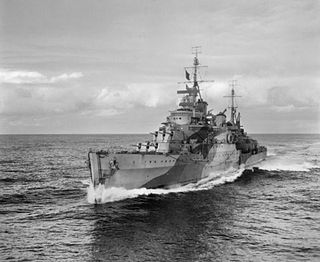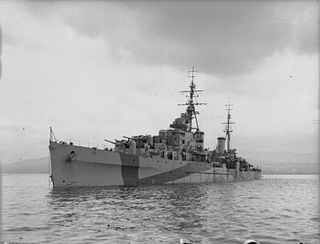
HMS Devonshire, pennant number 39, was a County-class heavy cruiser of the London sub-class built for the Royal Navy in the late 1920s. The ship spent most of her pre-World War II career assigned to the Mediterranean Fleet aside from a brief tour with the China Station. She spent the first two months of the Second World War in the Mediterranean until she was transferred to the Home Fleet and became flagship of a cruiser squadron. Devonshire took part in the Norwegian Campaign in mid 1940 and evacuated much of the Norwegian Government in June. Several months later, she participated in the Battle of Dakar, a failed attempt to seize the Vichy French colony of Senegal in September. The ship remained in the South Atlantic afterwards and supported Free French efforts to take control of French Equatorial Africa in addition to searching for German commerce raiders.

HMNZS Achilles was a Leander-class light cruiser which served with the Royal New Zealand Navy in the Second World War, the second of five in the class. Originally constructed by the Royal Navy, she was loaned to New Zealand in 1936 before formally joining the new Royal New Zealand Navy in 1941. She became famous for her part in the Battle of the River Plate, alongside HMS Ajax and HMS Exeter and notable for being the first Royal Navy cruiser to have fire control radar, with the installation of the New Zealand-made SS1 fire-control radar in June 1940.

HMS Fiji was the lead ship of the Fiji-class light cruisers built for the Royal Navy shortly before the Second World War. Completed in mid-1940, she was initially assigned to the Home Fleet and was detached to escort a force tasked to force French West Africa to join the Free French. The ship was torpedoed en route and required six months to be repaired. Fiji was then assigned to Force H where she helped to escort convoys to Malta. The ship was transferred to the Mediterranean Fleet in early May 1941. After the Germans invaded Crete a few weeks later, she was sunk by German aircraft on 22 May after having fired off all of her anti-aircraft ammunition.

The Tiger-class cruisers were the last class of all-gun cruisers completed for the British Royal Navy. They came from an order of eight Minotaur-class cruisers ordered in 1941-2, work on the second group of three ships being effectively suspended in mid 1944. The cruisers were finally completed with new armament, after a very long delay, entering service in the 1960s as the Tiger class.

The Town class was a 10-ship class of light cruisers of the Royal Navy. The Towns were designed to the constraints imposed by the London Naval Treaty of 1930. The ships were built in three distinct sub-classes, the Southampton, Gloucester and Edinburgh classes respectively, each sub-class adding on further weaponry.

The Dido class was a class of sixteen light cruisers built for the British Royal Navy. The design was influenced by the inter-war Arethusa-class light cruisers. The first group of three ships were commissioned in 1940, the second group and third group were commissioned between 1941–1942. A fourth group, also described as the Improved Dido, or the Bellona class, were commissioned between 1943 and 1944. Most members of the class were given names drawn from classical history and legend. The groups differed in armament, and, for the Bellona's, in function. The Dido class were designed as small trade protection cruisers, and were designed with five turrets, each with twin 5.25 guns in high angle mountings, far more modern in design than previous light cruiser turrets, and offering efficient loading up to 90 degrees to give some DP capability. While some damage was experienced initially in extreme North Atlantic conditions, modified handling avoided the problem. The fitting of the three turrets forward in A,B and C position depended on some use of aluminium in structure and the non availability of aluminium after Dunkirk was one of the reasons for only four turrets being fitted to the first group of three,while the third group had four turrets with twin 4.5 guns. The Bellona's were designed from the outset with four turrets, but with radar-guided guns, and carried an increased light anti-aircraft armament.

The C class was a group of twenty-eight light cruisers of the Royal Navy, and were built in a sequence of seven groups known as the Caroline class, the Calliope class, the Cambrian class, the Centaur class, the Caledon class, the Ceres class and the Carlisle class. They were built for the rough conditions of the North Sea, and proved to be rugged and capable vessels, despite their being somewhat small and cramped.

The Atlanta-class cruisers were eight United States Navy light cruisers designed as fast scout cruisers or flotilla leaders but that proved to be effective anti-aircraft cruisers during World War II. They were also known as the Atlanta-Oakland class. The four Oakland and later ships had slightly different armament as they were further optimized for anti-aircraft fire. The Atlanta class had 12 x 5-inch (127 mm)/38 caliber guns, mounted in three superfiring sets of two-gun turrets fore and three more aft. The first four ships of the class also had an additional two twin 5-inch/38 mounts, one port and one starboard, giving these first four Atlanta-class cruisers the heaviest anti-aircraft armament of any cruiser of World War II.

The Brooklyn-class cruiser was a class of nine United States Navy light cruiser built between 1935 and 1938. Armed with five triple 6-inch (150 mm) gun turrets, they mounted more main battery guns than any other standard U.S. cruisers. The Brooklyns were all commissioned between 1937 and 1939, in the time between the start of the war in Asia and before the outbreak of war in Europe. They served extensively in both the Pacific and Atlantic theaters during World War II.

The Minotaur class of light cruisers of the British Royal Navy, also known as the Swiftsure class, was designed as a modified version of the Crown Colony class incorporating war modifications and authorised in 1941. However, in spite of the heavy toll of cruisers in that year and the following one, the building of this new class had a relatively low priority and only three were completed by end of World War II. They played no significant part in the Second World War, though Swiftsure, as flagship of the British Pacific Cruiser Squadron, was selected by Admiral Cecil Harcourt to hoist his flag for the Japanese surrender at Hong Kong. Superb was completed to a slightly different design.

HMS Ceylon was a Crown Colony-class light cruiser of the Royal Navy. She was of the Ceylon sub class, named after the island of Ceylon. The cruiser saw service in the Atlantic and Pacific theatres during the Second World War. In the postwar era, she participated in actions in Egypt and the Korean War. In 1960 she transferred to the navy of Peru and renamed Coronel Bolognesi. The cruiser was scrapped in 1985.

HMS Cornwall, pennant number 56, was a County-class heavy cruiser of the Kent sub-class built for the Royal Navy in the mid-1920s. The ship spent most of her pre-World War II career assigned to the China Station. Shortly after the war began in August 1939, she was assigned to search for German commerce raiders in the Indian Ocean. Cornwall was transferred to the South Atlantic in late 1939 where she escorted convoys before returning to the Indian Ocean in 1941. She then sank the German auxiliary cruiser Pinguin in May. After the start of the Pacific War in December 1941, she began escorting convoys until she was transferred to the Eastern Fleet in March 1942. The ship was sunk on 5 April by dive bombers from three Japanese aircraft carriers during the Indian Ocean Raid.

HMS Bellona was the name ship of her sub-class of light cruisers for the Royal Navy. She was the first of the fourth group of Dido-class cruisers. Built to a modified design with only four twin 5.25-inch turrets, but with remote power control for quicker elevation and training, combined with improved handling and storage of the ammunition. The light AA was improved over earlier Dido cruisers, with six twin oerilikons and three quad "pom pom".

The Omaha-class cruisers were a class of light cruisers built for the United States Navy. They were the oldest class of cruiser still in active service with the Navy at the outbreak of World War II, being an immediate post-World War I design.

HMS Gambia was a Fiji-class light cruiser of the Royal Navy. She was in the service of the Royal New Zealand Navy (RNZN) as HMNZS Gambia from 1943 to 1946. She was named after the then Crown colony of the Gambia, and has been the only ship of the Royal Navy to bear the name.

HMS Swiftsure was a Minotaur-class light cruiser of the Royal Navy. She was laid down by Vickers Armstrong at Newcastle-on-Tyne on 22 September 1941, launched on 4 February 1943 by Lady Wake-Walker and commissioned on 22 June 1944. The first of a new Minotaur class, a development of the later Colony class with extra beam and a fifth twin 4 inch turret. Swiftsure was the last Royal Navy cruiser completed during World War Two and was the first British cruiser designed around the concept of an operations room and modern radar, with sensor screens and communications positioned for efficient operation. During her service in the Pacific in 1945, she proved the most efficient anti-aircraft cruiser in the fleet, and was the first Royal Navy cruiser with the 274 lock-and-follow radar targeting system for her main armament

HMS Bermuda was a Fiji-class light cruiser of the Royal Navy. She was completed during World War II and served in that conflict. She was named for the British territory of Bermuda, and was the eighth vessel of that name.

HMS Cambrian was a C-class light cruiser built for the Royal Navy during World War I. She was the name ship of her sub-class of four ships. Assigned to the Grand Fleet, the ship played only a small role during the war. Cambrian was assigned to the Atlantic and Mediterranean Fleets during the 1920s and was sent to support British interests in Turkey during the Chanak Crisis of 1922–23. The ship was placed in reserve in late 1929. She was sold for scrap in 1934.
HMS Superb was a Minotaur-class light cruiser of the Royal Navy. The ship entered service in 1945 and had a brief, quiet career before being decommissioned in 1957 after her modernisation was cancelled. She was broken up in 1960.
The Minotaur class, or Design Z, was a proposed class of light cruisers planned for the British Royal Navy shortly after the Second World War. Design Z had several proposed configurations with differing armament and propulsion arrangements. The designs were large ships that were planned to be armed with ten 6 in (152 mm) dual purpose guns and an extensive array of 3 in (76 mm) secondary guns. Six ships of the class were planned in 1947 but they were ultimately cancelled before construction could begin, owing to the post-war economic difficulties of the United Kingdom and shifting naval priorities.


















